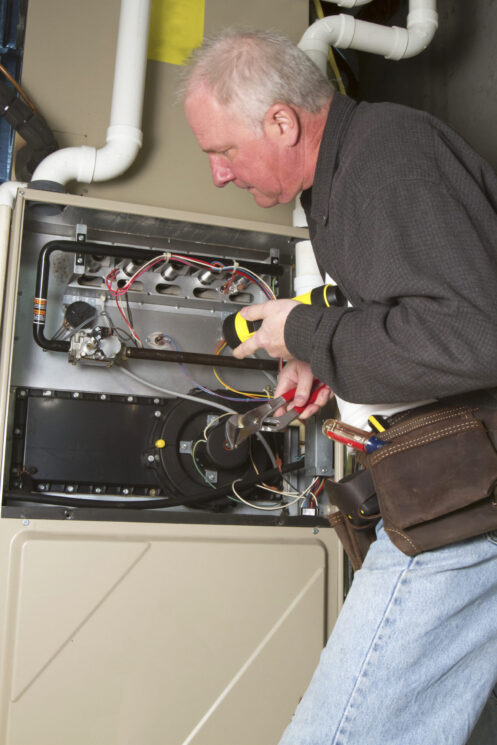March 16, 2024

What Color Should My Furnace Flame Be?
If you have a commercial property in the St. Louis area, you need a way to keep it warm. This is not just a matter of keeping things comfortable: Low temperatures can damage your property. Cool weather can cause condensation, and the moisture that accumulates can cause mold and water damage over time. When it gets even colder, you could have water freeze in your pipes, which may cause them to burst. Some businesses also need to protect delicate tools or temperature-sensitive materials from cold weather to keep them from damage.
Those factors mean that you need to invest in a furnace to protect your property and keep your business operating normally when it gets cold. You also need to make sure the new furnace is the right size for your property. A furnace that is too small will not be able to keep your business warm, but one that is too big will be inefficient. There are five big factors that you should keep in mind when deciding which size you need.
1. Start With Basic Rules of Thumb
The size of your property will provide a good starting point for estimating the size of your furnace. In general, you should start by assuming that you need a furnace that can produce 40-50 British Thermal Units (BTU) per square foot. Your furnace’s efficiency rating will not change this. That rating measures not the total amount of heat produced but the amount of energy that it needs to release the desired amount of heat into the home.
This is an easy calculation, but it is only the first step in determining which furnace you need. You cannot rely on it exclusively because some buildings need more heat than others, whether that is due to insulation considerations, a quirk of the local area, or any number of other factors. Keep this rule of thumb in mind to set your basic expectations, but remember to look at the other factors to determine if you will need a bigger or smaller furnace than your square footage implies. Professionals have access to specialized calculations to help you with the overall picture.
2. Take Insulation Into Account
Insulation should be the next consideration because in most cases it will be the biggest factor other than the property’s size. Insulation works by lowering the building’s rate of heat loss, which allows you to keep it at a given temperature with less energy. There are a lot of different types of insulation, so you may need to do a little research about your building to figure out how well-insulated it is.
In general, you can assume that newer buildings will have significantly more insulation than older ones. That is partly due to design priorities because people usually care more about energy efficiency now than they did in the past. Insulation tends to degrade over time, which is the other major reason that new buildings tend to need less heating than older ones. That also means that old buildings can benefit from an inspection to see if the insulation still works.
3. Think About Architecture
Many architectural features affect how much heat it takes to maintain your target temperature. For example, a building with high ceilings will have a greater interior volume than one with low ceilings. That increases the volume of air that you need to heat, which means you will need a significantly larger furnace than your square footage implies. On the other hand, low ceilings reduce the total volume of the buildings, which reduces the amount of heat that it needs.
Windows work the same way. They usually have less insulation than the walls, so they can allow heat to escape from the building. The good news is that modern windows are often designed with insulation in mind. They do a lot to inhibit heat transfer. In some cases, they can even reduce your heating needs by allowing light to enter the building while preventing heat from leaving. You will need to determine what type of windows are installed in your building if you want to assess their impact on heat retention.
This is another area where new buildings tend to outperform old ones but not to the same extent as with insulation. You can replace old windows with modern, efficient designs to get more from them. Treat age as a rule of thumb, and always try to figure out the details of your structure’s assets if you can manage it.
4. Examine the Rest of the Property
The area around your property can have just as much of an effect on your heating costs as the building itself. Good landscaping will help your property conserve heat, which means you can get away with a smaller furnace. You might not be able to make adjustments to the area around your property, but you should take a look at it to see how it will affect you.
If your property is surrounded by trees or anything else that can act as a windbreak, it will reduce your heating costs. Buildings slowly lose heat over time during cold weather, but high winds will increase the rate of heat loss. The effect is similar to using a fan to increase airflow in a room. Windbreaks along the northern side of the property will usually offer the greatest benefit.
You should also check to see if your property can receive significant sunlight during the winter. The sun will not be enough to heat your property unless the space was initially designed for passive solar heating, but it can help to offset a winter chill. If the southern side of your building gets regular sunshine, you can expect a slight reduction in your heating bills.
5. Consider How You Use Your Property
The human element is the final factor that you need to consider. Think about how you use your property and how that will affect your heating requirements. For example, a restaurant or bakery will produce a huge amount of heat by running ovens throughout the day. They can get away with a smaller furnace than other businesses because their ovens will compensate for the furnace’s reduced output, especially if the building has enough insulation to retain heat when the business is closed.
Start With Professional Help
You’ll need to consider many different factors when deciding what size your new commercial furnace should be, so it is natural to feel overwhelmed by the options. The good news is that you do not need to figure that out on your own. Scott-Lee Heating Company can take you through the process and help you determine which furnace will meet your needs as efficiently as possible. We will make sure that you get a furnace that strikes a good balance between thermal output, energy efficiency, and price. Once you have made your decision, we can take you through your financing options, install the new furnace, and handle maintenance for it in the future. If you are ready to make your choice, get in touch with us at Scott-Lee Heating Company.
